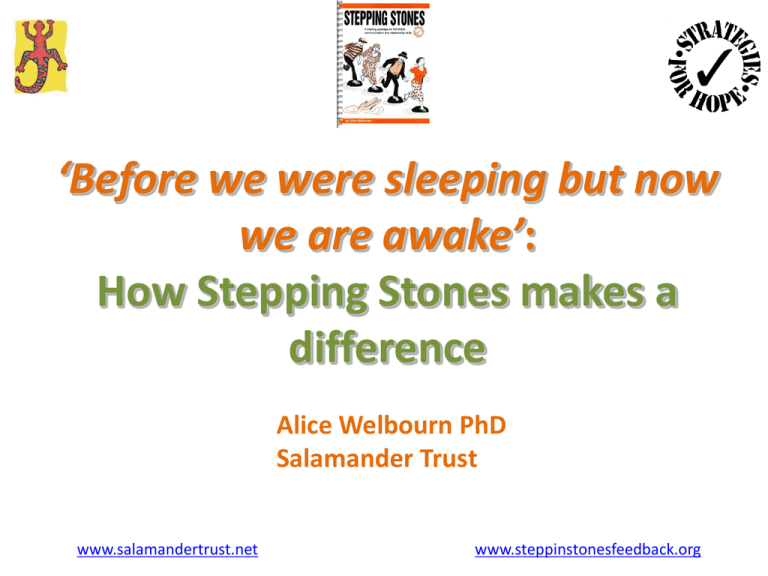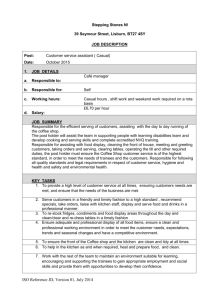
‘Before we were sleeping but now
we are awake’:
How Stepping Stones makes a
difference
Alice Welbourn PhD
Salamander Trust
www.salamandertrust.net
www.steppinstonesfeedback.org
What is ‘Stepping Stones’?
Participatory HIV prevention programme that aims to
improve sexual health through building stronger,
more gender equitable relationships.
• 240 Page manual for trainers (optional video) (1995)
Instructions on how to run 60 hours of workshop
sessions, divided into around 18 sessions over 10-12
weeks.
• Stepping Stones Plus manual (2008): positive health,
dignity and prevention; positive people’s SRR, rights
• Worldwide Community of Practice of 900
organisations
How does it work?
• Grounded in local knowledge, context and experience community members are learners and actors
• Addresses social norms and structural causes of vulnerability
- change at individual, group, community and services level
• Works with young and older men and women in peer groups,
separately and together – leads to group change across
genders and generations
• Uses creative experiential activities to generate ‘critical
literacy’
• Coherent sequence of sessions
• Encouragement of groups to share learning and change with
others
Older Women’s Group, Uganda, 16 months after the workshop…
Neighbours sharing and
supporting each other
Alcohol reduction
(so more $)
♀marriage rights
Will-writing for
inheritance rights
Care and support for sick &
their carers
Communication
(reduced IPV)
Talking to Children about sex &
relationships (prevention
education)
Peer-based condom
distribution
Stepping Stones is based on the SocioEcological Model of behavioural change
Blum’s theory:
A Contextual Model
Macrolevel
Environmental
Factors
Proximal Level
Environmental Individual
Factors
Factors
Response
Outcome
Biological
Factors
Policies
Involuntary
Response
Family
Neighborhood
Peers
Early Sexual
engagement
Individual
Response
Customs
School
Voluntary
Response
Social change
Temperament
& Cognitive
Factors
Wheel of Change
Changing
Learning
Caring*
Sharing
*When boys start to talk publicly about caring for affected people we know that norms
are changing because they can express these feelings without ridicule
The 4 peer
groups’ paths…
YW
YM
OM
OW
The 4 Themes..
PLANS
AHEAD
Plenary
4: WAYS IN
WHICH
WE CAN CHANGE
– K-N
Critical literacy
development ……..
3: WHY DO WE BEHAVE
AS WE DO? – G-J
2: HIV & SAFER SEX – E,F
1: GROUP COOPERATION – A,B,C,D
INTRODUCTION – Plenary1
Community of
inquiry…….
With whom has Stepping Stones
been Introduced?
People with disabilities (eg India)
Pastors and Imams and their congregations (Kenya,
Gambia)
School pupils and teachers (many countries)
NGO staff (eg Tanzania)
People living with HIV and AIDS (eg Zimbabwe,
Namibia, RedCA, Fiji+, PIAF)
National and constituency AIDS Control Councils
(Gambia, Fiji, Solomons..)
Girls and boys out of school (many countries)
Women’s rights groups (many countries)
Health staff (Mumbai)
Drug using communities (Myanmar, Russia,
Kazakhstan…..)
People in prison (Morocco, India)
University staff and students (Namibia)
LGBT Communities (Caribbean)
Post-trauma communities eg Liberia, Mozambique
Extent of scale up – 1995 - 2009
• 20,000 copies of the manual to over 5,000
organisations in 100 countries in Africa, S and E Asia,
Latin America, Pacific, Eastern Europe, C Asia
• 14 languages and adaptations for 17 settings
• Groups include marginalised and stigmatised groups,
schools and health services, military and people in
conflict zones
• Continuing expansion of use
“Almost certainly the most widely used intervention of
its kind in the world” Rachel Jewkes, MRC South
Africa
English (by
SFH)
French (by
SFH)
Portuguese
South Africa
Ki-Swahili
Indian
Bangla
L American
Indonesian
Pacific
How has scale up happened?
• Field testing in Gambia – research by MRC to national scale up
• International training of trainers and in-country adaptation and
training by INGOs. Plan, Alliance, IPPF
• Regional TOT and adaptations – South Asia, Latin America
• Stepping Stones networks of trainers and regional co-ordinators
• Appreciation of the package and sharing with others. Positive
reports and reviews. Word of mouth. Organic.
• Local expansion in and between communities
• National expansion across districts, new organisations and groups –
Zambia, India, Gambia, Pacific, Myanmar to Russia…
• Low cost distribution centres -TALC, Strategies for Hope
• Feedback and networking - SS Website, global meetings –Oxford
• Unique characteristics – “gender and generation”
Achievements from SS evaluations (36)
• Universal support and appreciation for SS as a change process
from those with first hand experience of using /seeing it
• Improvement in communication between spouses or children
and parents, especially about sex
• Better gender relations – greater equality, mutual respect and
empathy, increased respect for women’s rights, sharing
household work, improved sexual relations.
• Better intergenerational relations, more care about welfare of
children
• Closer peer group relations – positive peer pressure
• Reduced alcohol consumption and intimate partner violence
• Increase in safer sex practices
• Economic changes – more sharing in the household
Investing in SS
• Scale up of effective Stepping Stones programmes requires
major investment. Donors, NGOs and communities need to be
sure that this represents a good use of scarce resources.
• Evaluation that provides statistical evidence of SS value-added
for public health outcomes requires a large sample and expert
researchers. This is costly and may be difficult to attribute and
generalise. RCT costs….
• Evaluations using participatory qualitative methods
triangulated with practical quantitative methods are
grounded in reality and if they converge from a large number
of sites, they represent strong evidence
Importance of strengthening M and E
Need to design and expand high standard monitoring and
evaluation which engages stakeholders, is triangulated
and gives enough information to:
– Make a sound judgement on value for money.
– Consolidate and refine programme implementation
• Information on process indicators on coverage, ‘dose’
and quality needs to be standardised and complete
• Qualitative evidence of knowledge, attitude, skill and
behaviour change plus numbers on who has changed,
who has not and why
• Identify ways to measure increased safer sex practice,
use of services and improved well-being
NB: S Africa results from 2 same-age peer groups only – no inter-generational dimension.
Reason: cost of conducting an RCT too prohibitive with 4 peer groups
NB: S Africa results from 2 same-age peer groups only – no inter-generational dimension.
Reason: cost of conducting an RCT too prohibitive with 4 peer groups
By Rachel Jewkes
NB: S Africa results from 2 same-age peer groups only – no inter-generational dimension.
Reason: cost of conducting an RCT too prohibitive with 4 peer groups
By Rachel Jewkes
GAMBIA
*
*
*
*
*
*
Costings
Zimbabwe town: $3450 for 30 participants = $115 each with accomm.
Zimbabwe rural $820 for 20 participants = $41 each
S Africa: ca $33 per participant
India: ca $55-65 per participant initially, falling to $43 per participant
Zambia (Lusaka): ca $62 per participant - high room hire costs
Russia 15 days sessions for 80 people = $11,000 (total costs) =
$140 per person
Mozambique: 2003 – World Bank. 500,000 participants $1.19 per
participant over 4 years. Fully achieved 10 of the 16 UNAIDS
benchmarks. Partially achieved 4 more (eg no homophobia training,
limited M&E, not schools-based)
The Gambia: 2006 - $295 per participant (1 village 500 participants 1
year) down to $15 per participant on scale up (to 20 village of 500
participants each in 1 year – ie 10,000 participants)
Recommended…..
Microcredit programmes (S Africa, India)
Always with 4 peer groups
Add Other materials (see eg website)
Complementary interventions at other
levels (service delivery, legal, economic
etc.)
Long-term commitment…. (cf smoking
60 years….)
Ongoing developments
Stepping Stones PLUS
Stepping Stones for Children
Thanks…
to Gill Gordon, Amandine
Bollinger, Rachel Jewkes
and all the communities
addressing these complex issues in
their lives worldwide







